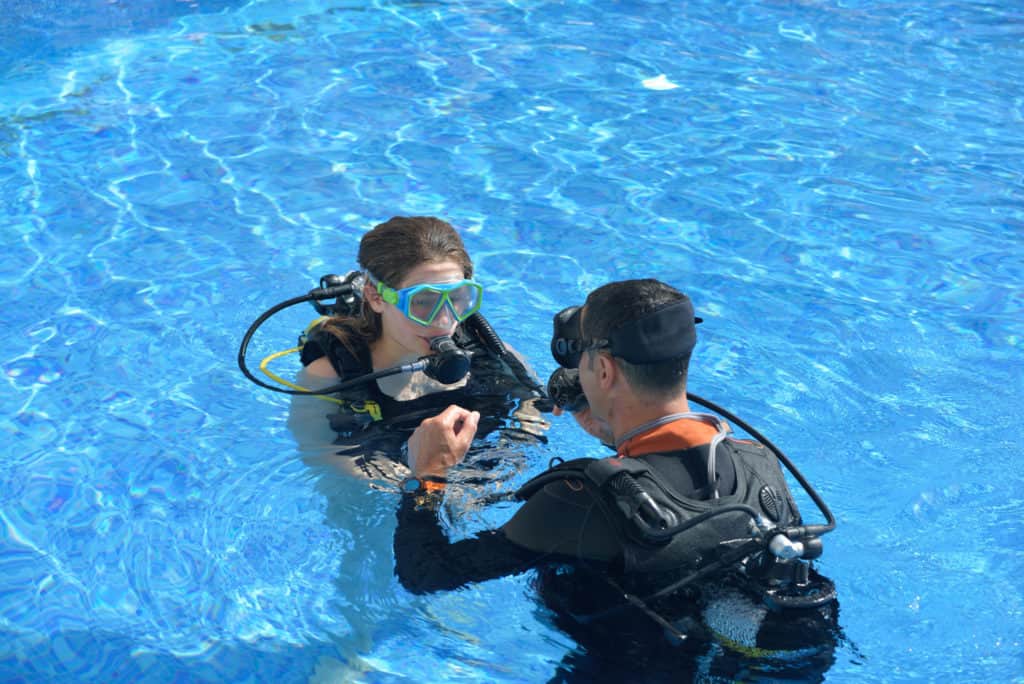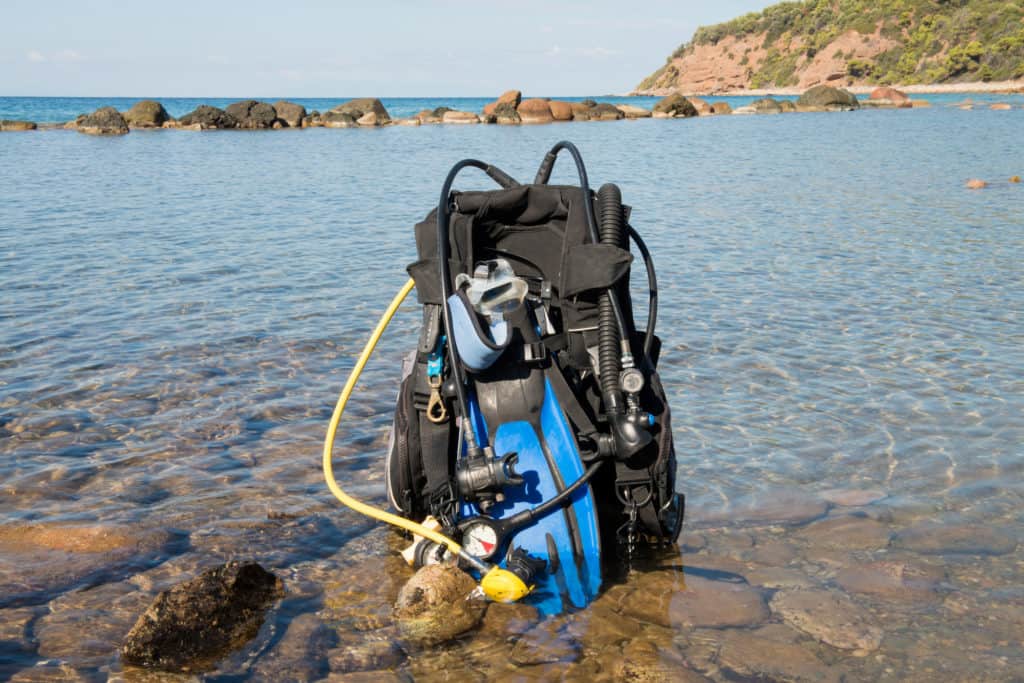If you’re going to get your feet wet (literally!) and discover the fascinating world that awaits you underneath the water, the PADI Open Water Diver Course is your first step in your education process!
What To Expect From Your PADI Open Water Course?
Becoming a scuba diver is no easy task. There’s training and practice that are required to ensure you can dive safely and know how to dive.
The PADI Open Water Course is the beginning level of the PADI education program that allows you to become a diver.
Recognized across the world, by obtaining your PADI license, you can dive in a whole bunch of locations, and begin to feel comfortable beneath the waves.
What Are The Requirements For Learning To Scuba Dive?
The minimum age to learn how to scuba dive is 10 years old, but the upper age is (almost) limitless! Many older people discover scuba diving as a sport as it keeps them healthy but is a low impact on joints.
You need to be generally fit and healthy. All student divers are required to complete a brief scuba medical questionnaire that asks about medical conditions that could be a problem while diving. If none of these apply, sign the form and you’re ready to start. If you are concerned about your medical health, have a doctor examine you and confirm you are fit to dive.
You need to have basic water skills. This doesn’t mean you need to be able to swim like a shark! But part of the course requirements asks for you to be able to swim for swim 200 metres/yards (or 300 meters/yards in mask, fins, and snorkel) without stopping. There is no time limit for this, and you may use any swimming strokes you want. You also need to be able to float and tread water for 10 minutes, again using any methods you want.

How Long Does The PADI Open Water Course Take?
The PADI Open Water course usually takes 3 days to complete, with a mixture of confined water sessions and open water dives.
Prior to getting wet though, you’ll need to complete some theory study, which can be done from a textbook, or as e-learning.
What Does The Theory Entail?
The PADI Open Water Theory comes as a textbook, or as e-learning. There are five chapters to cover, with five Knowledge Reviews (one per chapter), four quizzes, and one final exam. All that you read will be discussed with your instructor who can help explain anything you didn’t quite understand.
We recommend planning time to do this before your course, as it can be onerous to need to read the textbook at the same time as the learning. And you will need the information from what you have read during your practical dives.
What Are The Confined Water Sessions Like?
You begin your dive sessions in a confined water setting. After learning and practicing how to set up your scuba equipment, you will learn how to put on your equipment and enter the water.
You will practice special hand signals, mask, regulator, and buoyancy skills. You will also practice different emergency skills, such as how to react to being out of air and the safe way to ascend to the surface. Plus some acronyms and scuba vocabulary that you’ll need to know too!
Your instructor will work with you until you can complete the skills comfortably. You’ll repeat most of these skills in your open-water sessions too.
What Are The PADI Open Water Sessions Like?
You need to complete 4 open water dives to complete your course.
On each dive, you will repeat some skills learned in the confined water session, like mask clearing, regulator recovery, performing a buddy check, and different buoyancy procedures.
It’s just a refresh of the skills you already practiced, but in the ocean instead. The majority of the dive is just spent diving, as the best way to learn is through doing it and practicing!
What Equipment Do I Need?
To start your course you don’t need any equipment. Here at DivePoint, we have rental gear for divers to use. It can become an expensive hobby, so expecting you to buy your full kit before you’ve even dipped your toe into the water is unreasonable!
Plus by renting equipment, you can try different brands which may help you to find preferred styles when you do come to invest in your own gear.
Depending on the season, and where you dive, you may also find renting a wetsuit is easier in order to have the correct warmth and thickness for the dives you are doing.
If you are keen to have some equipment before you dive, you may wish to invest in your own mask (especially if you need prescription glasses). When buying a mask, go to your local dive shop and try on many varieties. Each fits different face shapes and some can suit you more than others. You can’t really tell without trying them on!
Test a mask by placing it against your face (without the strap) and breathing in through your nose. It should create a seal against your face and stick. This means it should be a good fit for you under the water too!

Do I Have To Be A Good Swimmer To Scuba Dive?
Not at all, but obviously it will help! As mentioned in the requirements, there is a water skills test as part of the certification, but this is not timed and you can doggy paddle your way through it! Once beneath the water, the techniques used by divers differ slightly from swimming strokes (divers don’t use their hands for a start!) so being a good swimmer isn’t strictly needed.
Where Is The Best Place To Get Certified?
Well, here at DivePoint Mexico, we think that here in Playa del Carmen is one of the best places to get certified.
This is because the local reefs in this area are between 12 to 15 meters deep, which is a perfect depth for new divers. They stay reasonably flat allowing you to manage your buoyancy more easily while getting used to how your scuba equipment.
There also isn’t a lot of current here, making it easier to learn and safer for new divers.
Once you have completed the course, there are lots of different sites within the Open Water Diver Depth range for you to discover too. You may even want to try diving a cenote!
What Can I Do Once I Am Certified as a PADI Open Water Diver?
Once certified, you are able to dive across the world, with a dive buddy who is also certified, to a limit of 18 meters. You are technically able to plan and lead your own dives, but I would recommend going with a local divemaster if you go on dive trips in new areas who can help you if you have any issues, and show you the best places underwater to explore.
If you wish to further your education, there are more programs, such as the PADI Advanced Open Water Diver, which allow you to dive deeper and help you to refine your buoyancy, navigation, and other diving skills.
There are also other PADI Specialty courses, such as Wreck Diver, Underwater Photographer, Deep Diver, and many more you may wish to explore too!
What Other Advice Can You Give Me?
Enjoy your course!
Use your time with your instructor to ask as many questions as possible and don’t be afraid of making ‘mistakes’ – it’s how you learn!
Your instructor wants you to leave the course as a confident and safe diver, so they will work with you on your skills until you feel comfortable.
Book your open water course with DivePoint Mexico today!


